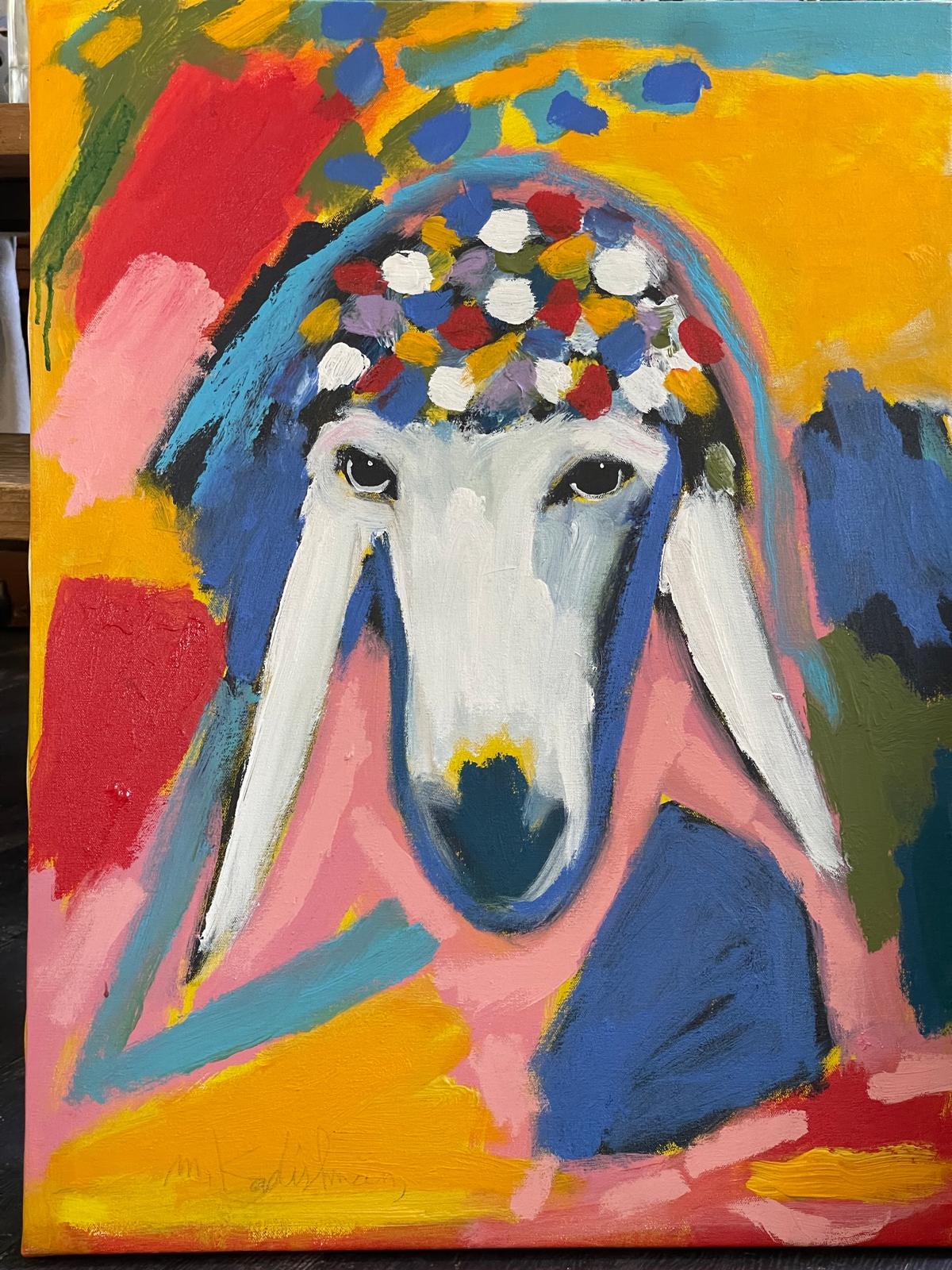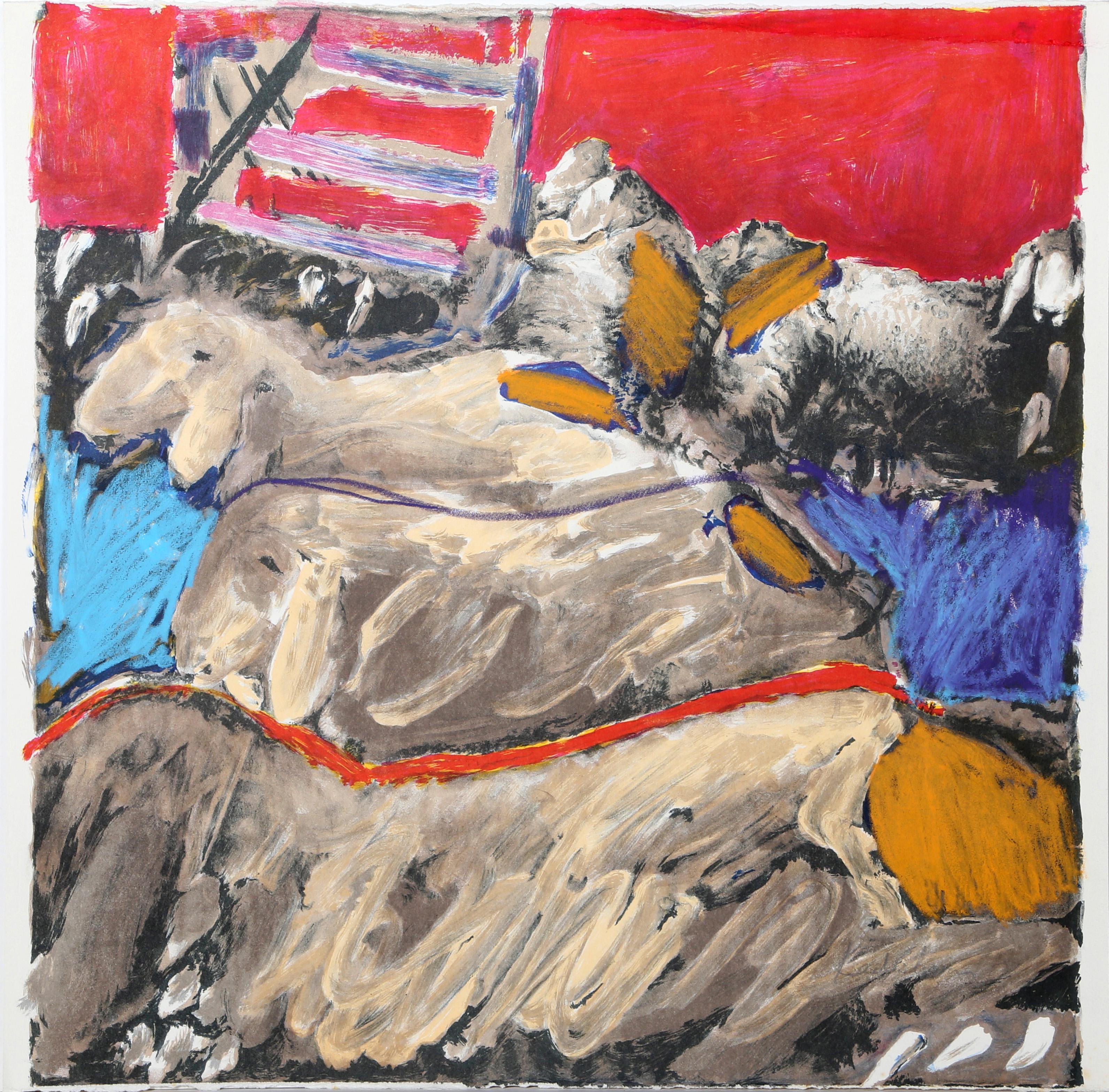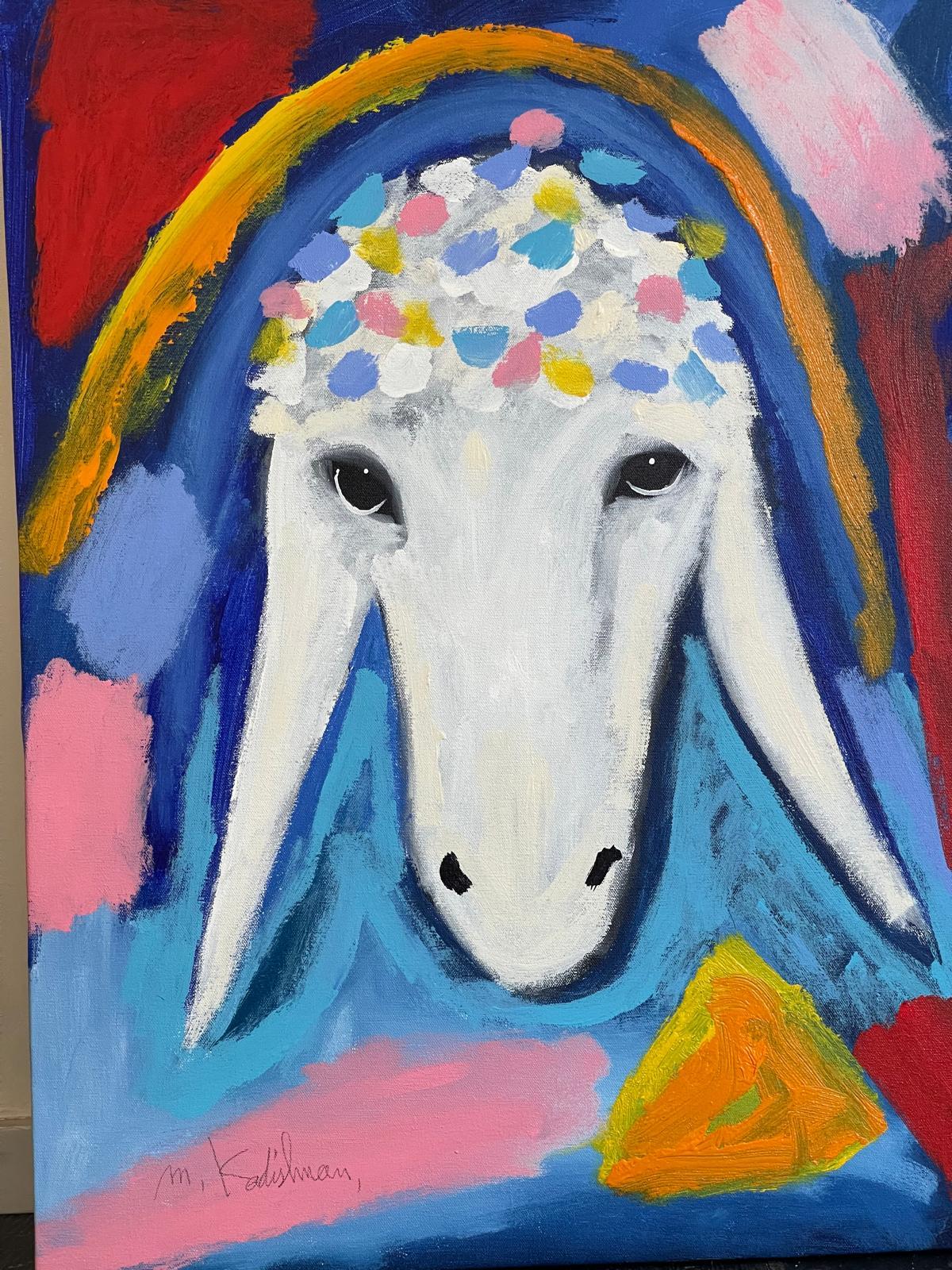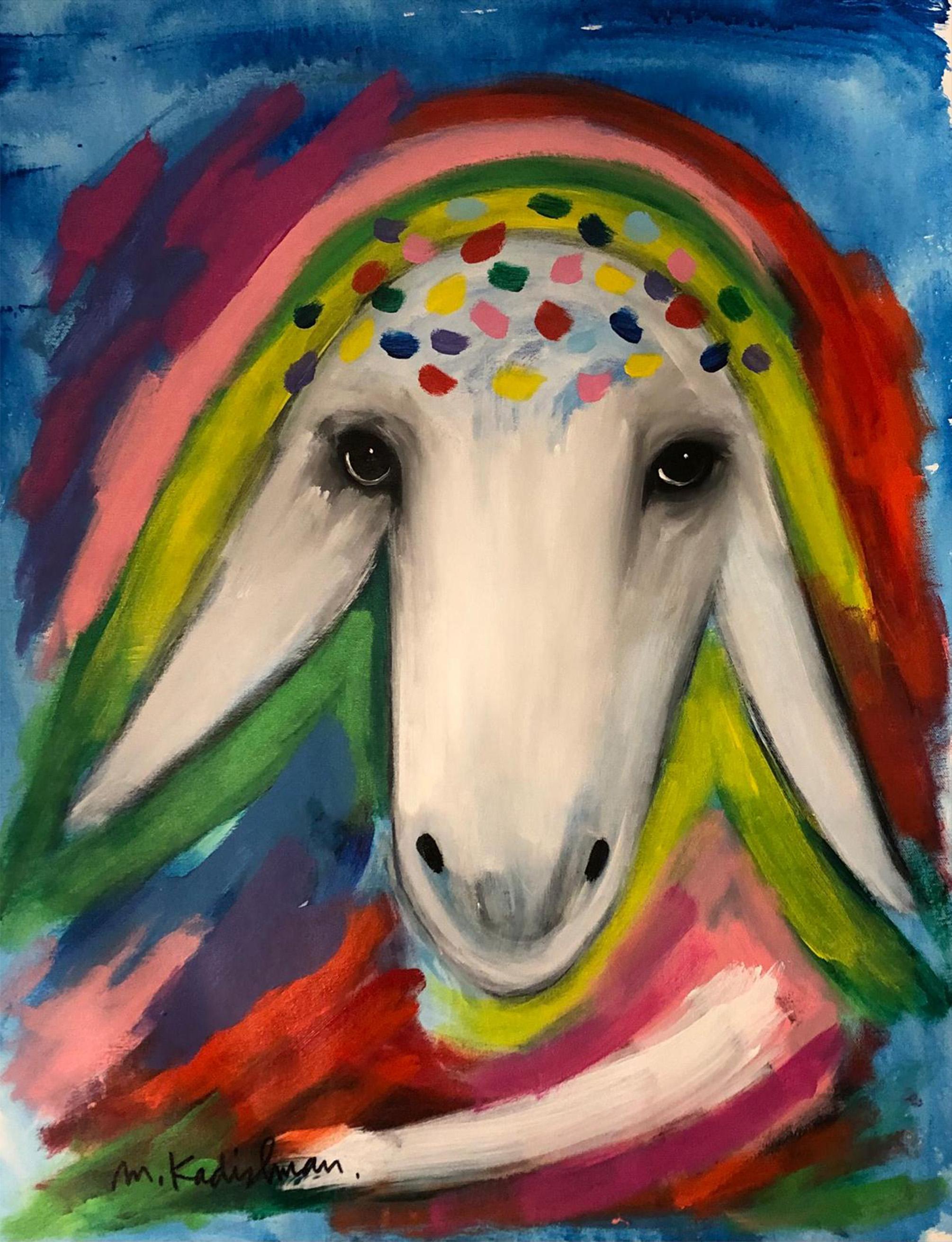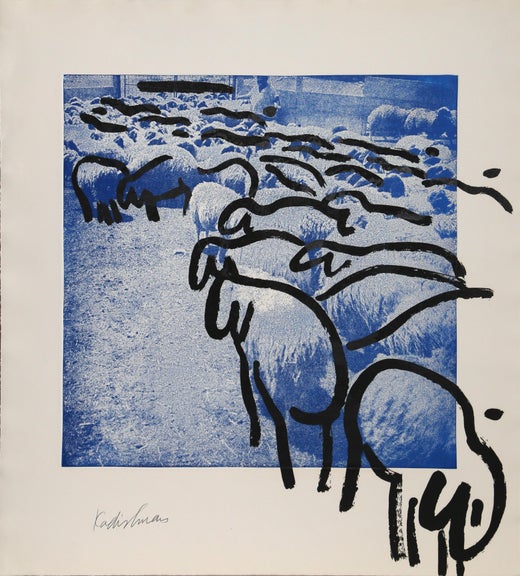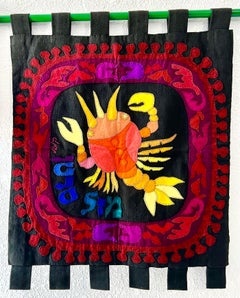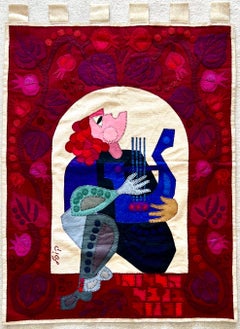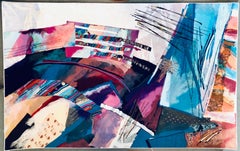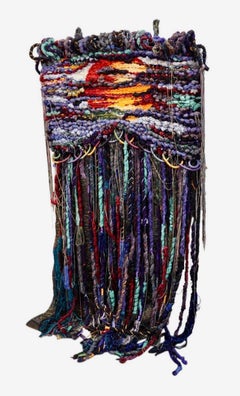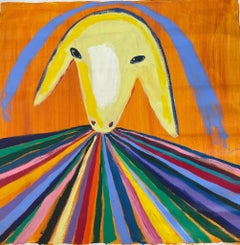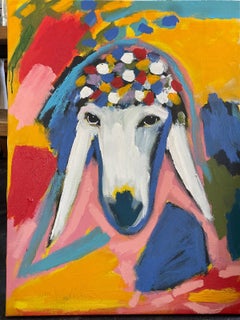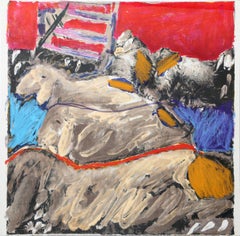Items Similar to Israeli Hand Woven Colorful Wool Tapestry Weaving Menashe Kadishman Sheep Head
Want more images or videos?
Request additional images or videos from the seller
1 of 15
Menashe KadishmanIsraeli Hand Woven Colorful Wool Tapestry Weaving Menashe Kadishman Sheep Head
$2,800
£2,143.27
€2,460.13
CA$4,000.46
A$4,389.91
CHF 2,272.92
MX$52,550.83
NOK 28,516.05
SEK 26,828.12
DKK 18,376.08
About the Item
Beautiful hand woven tapestry by renowned Israeli sculptor Menashe Kadishman. Super quality, and visually stunning.
It measures about 32.5 X 27.5 inches
It is signed with initials.
This is similar to an Aubusson style flat weave hand woven wool tapestry. This is most probably from the George Goldstein Atelier in Jerusalem. (Originally known as Nazareth Tapestries) They produced genuine handmade Gobelin tapestries in Israel). This does not bear a label. In 1964 the first French style weaving studio was inaugurated in Israel, in the new city of Nazareth Ilit. With the encouragement of master Jean Lurcat, woven upon several contemporary masters’ original sketches, such as Jean Lurcat, Hans Hartung, Adolph Gottlieb, Karel Appel, Yaacov Agam, Mordecai Ardon, Reuven Rubin, Danny Caravan, and more. Some of these tapestries encountered their moments of glory during the international exhibitions, such as in the Museum of Modern Art (NY), “Expo Montreal” (Canada), Biennale of Lausanne (Switzerland), and others. In 1967, after the Six-Day War, Nazareth’s workshop closed its doors and returned to Jerusalem where he opened a new studio with a young team made up of eighteen artisans, dedicating their work more specifically towards Israeli artists. The tapestries are woven upon the original sketches of Yohanan Simon, Naftali Bezem. They can be seen hanging on the wall of the Israeli President’s residence, the Yeshiva University of New York, the University of Haifa, New York Bank Discount, as 60-square meter tapestries for the Shaare Zedek Medical Center, Jerusalem, and in ceremonial art. Tapestries for Parochet and Torah mantles are seen in Washington, Bet-El Springfield, Babson College, Boston, Bet-El Univ. Andover, Bet-El Highland Park and the Strasbourg Great Synagogue in France. Along with Itche Mambush in EIn Hod these were the fine, Gobelin style modern art tapestry weavers of Israel.
Menashe Kadishman was born in Tel-Aviv in 1932. He is a Graduate of St. Martin's School of Art, University of London. From 1947 to 1950, Kadishman studied with the Israeli sculptor Moshe Sternschuss at the Avni Institute of Art and Design in Tel Aviv, and in 1954 with the Israeli sculptor Rudi Lehmann in Jerusalem. In 1959, he moved to London, where he remained until 1972. He had his first one-man show there in 1965 at the Grosvenor Gallery. His sculptures of the 1960s were Minimalist in style and so designed as to appear to defy gravity. This was achieved either through careful balance and construction, as in Suspense (1966), or by using glass and metal so that the metal appeared unsupported, as in Segments (1968). In 1995, he began painting portraits of sheep. These instantly-recognizable sheep portraits soon became his artistic trademark. In 1990, Kadishman was awarded the Dizengoff Prize for Sculpture and in 1995 he was awarded the Israel Prize, for sculpture.Kadishman was an America-Israel Cultural Foundation scholarship recipient from 1960-1962.
Menashe Kadishman was born in Tel-Aviv in 1932. He is a Graduate of St. Martin's School of Art, University of London Studies with Anthony Caro, Reg Butler. From 1947 to 1950, Kadishman studied with the Israeli sculptor Moshe Sternschuss at the Avni Institute of Art and Design in Tel Aviv, and in 1954 with the Israeli sculptor Rudi Lehmann in Jerusalem. In 1959, he moved to London, where he remained until 1972. He had his first one-man show there in 1965 at the Grosvenor Gallery. His sculptures of the 1960s were Minimalist in style and so designed as to appear to defy gravity. This was achieved either through careful balance and construction, as in Suspense (1966), or by using glass and metal so that the metal appeared unsupported, as in Segments (1968). In 1995, he began painting portraits of sheep. These instantly-recognizable sheep portraits soon became his artistic trademark. Along with Reuven Rubin and Yaacov Agam he is one of Israel's most famous artists. In 1990, Kadishman was awarded the Dizengoff Prize for Sculpture and in 1995 he was awarded the Israel Prize, for sculpture. This was from a portfolio that included Ivan Schwebel, Michael Gross, Liliane Klapisch and Moshe Kupferman, five of Israel's leading contemporary artists who were each approached in May 1977 with a request to contribute a hand-printed screenprint for a portfolio to be titled "Jerusalem". The sole term of reference was the name "Jerusalem", with no qualifications at all. The five artists then spent time working completely independently and individually on the project at the Jerusalem Print Workshop. Each screenprint was hand-signed by their respective artist and numbered from the edition of 200, hand-printed on BFK Rives paper Published by Whartman and Sacks Art Publications
Kadishman was an America-Israel Cultural Foundation scholarship recipient from 1960-1962.
Selected one man exhibitions
1965 Kadishman, Sculptures - Grosvenor Gallery, London. Curator Charles Spencer
Harlow Arts Festival - Harlow, England
1967 Dunkelman Gallery, Toronto
1968 Edinburgh International Festival - Goldbergs & The Richard Demarco Gallery
1970 Menashe Kadishman / Yellow Forest - Jewish Museum, New York. Cur. Tejas Englesmith, asso. curator Edward Fry
1971 The J.L. Hudson Gallery, Detroit, Michigan
1972 Menashe Kadishman, Concepts and their realization - Mus. Haus Lange, Krefeld. Cur. Paul Wember
Yellow Square, Valley of the Cross, Jerusalem
1975 Canvas Forest/Laundry - Israel Museum, Jerusalem. Curator Yona Fisher
Menashe Kadishman : Glass - Julie M. Gallery, Tel Aviv
1976 M. Kadishman : Glass - Rina Gallery, New York
1977 Unicorn Gallery, Copenhagen
1978 The Venice Biennale, The Israeli Pavilion. Curator Amnon Barzel
Select Group Exhibitions
Genia Schreiber University Art Gallery, Tel Aviv
Abramson, Larry Avigdor Arikha, Dei Ben Shaul, David Michail Grobman, Michael Gross, Uri Lifschitz, Ofer Lellouche, Menashe Kadishman, Shaul Schatz and others.
Israel Pollak School of Art Kalisher Five, Art Sc, Tel Aviv
Abramson, Larry Menashe Kadishman, Pinchas Cohen Gan, David Reeb, Arnon Ben David, Moshe Gershuni and other.
Selected one man exhibitions
1965 Kadishman, Sculptures - Grosvenor Gallery, London. Curator Charles Spencer
Harlow Arts Festival - Harlow, England
1967 Dunkelman Gallery, Toronto
1968 Edinburgh International Festival - Goldbergs & The Richard Demarco Gallery
1970 Menashe Kadishman / Yellow Forest - Jewish Museum, New York. Cur. Tejas Englesmith, asso. curator Edward Fry
1971 The J.L. Hudson Gallery, Detroit, Michigan
1972 Menashe Kadishman, Concepts and their realization - Mus. Haus Lange, Krefeld. Cur. Paul Wember
Yellow Square, Valley of the Cross, Jerusalem
1975 Canvas Forest/Laundry - Israel Museum, Jerusalem. Curator Yona Fisher
Menashe Kadishman : Glass - Julie M. Gallery, Tel Aviv
1976 M. Kadishman : Glass - Rina Gallery, New York
1977 Unicorn Gallery, Copenhagen
1978 The Venice Biennale, The Israeli Pavilion. Curator Amnon Barzel
- Creator:Menashe Kadishman (1932, Israeli)
- Dimensions:Height: 33.5 in (85.09 cm)Width: 27.5 in (69.85 cm)
- Medium:
- Movement & Style:
- Period:
- Condition:
- Gallery Location:Surfside, FL
- Reference Number:1stDibs: LU38214077212
Menashe Kadishman
Menashe Kadishman was born in Mandate Palestine. His father died when he was 15 years old. He left school to help his mother and provide for the family.[1] From 1947 to 1950, Kadishman studied with the Israeli sculptor Moshe Sternschuss at the Avni Institute of Art and Design in Tel Aviv, and in 1954 with the Israeli sculptor Rudi Lehmann in Jerusalem. In 1950–1953, Kadishman worked as a shepherd on Kibbutz Ma'ayan Baruch. This experience with nature, sheep and shepherding had a significant impact on his later artistic work and career. In 1959, Kadishman moved to London to study at Saint Martin's School of Art and the Slade School of Art.[2] In 1959-1960 he also studied with Anthony Caro and Reg Butler.[2] He had his first one-man show there in 1965 at the Grosvenor Gallery. In 1972, he returned to Israel. In the 1960s, Kadishman's sculptures were Minimalist in style, and so designed as to appear to defy gravity. This was achieved either through careful balance and construction, as in Suspense (1966), or by using glass and metal so that the metal appeared unsupported, as in Segments (1968). The glass allowed the environment to be part of the work. The first major appearance of sheep in his work was at the 1978 Venice Biennale, where Kadishman presented a flock of colored live sheep as living art.[4] In 1995, he began painting portraits of sheep by the hundreds, and even thousands, each one different from the next. These instantly-recognizable sheep portraits soon became his artistic "trademark"
About the Seller
4.9
Platinum Seller
Premium sellers with a 4.7+ rating and 24-hour response times
Established in 1995
1stDibs seller since 2014
1,820 sales on 1stDibs
Typical response time: 1 hour
- ShippingRetrieving quote...Shipping from: Surfside, FL
- Return Policy
Authenticity Guarantee
In the unlikely event there’s an issue with an item’s authenticity, contact us within 1 year for a full refund. DetailsMoney-Back Guarantee
If your item is not as described, is damaged in transit, or does not arrive, contact us within 7 days for a full refund. Details24-Hour Cancellation
You have a 24-hour grace period in which to reconsider your purchase, with no questions asked.Vetted Professional Sellers
Our world-class sellers must adhere to strict standards for service and quality, maintaining the integrity of our listings.Price-Match Guarantee
If you find that a seller listed the same item for a lower price elsewhere, we’ll match it.Trusted Global Delivery
Our best-in-class carrier network provides specialized shipping options worldwide, including custom delivery.More From This Seller
View AllWool Felt Applique Israeli Folk Art Signed Tapestry Kopel Gurwin Bezalel School
By Kopel Gurwin
Located in Surfside, FL
This depicts a Crab, In Hebrew Mazel Sartan (the Zodiac symbol Cancer, June-July) all made by hand. woven and stitched.
Kopel Gurwin (Hebrew: קופל גורבין) (1923–1990) was an Israeli tapestry wall hanging, painter and graphic artist.
Kopel (Kopke') Gurwin (Gurwitz) was born and raised in Vilna, the capital of Lithuania. He spoke Yiddish at home, but simultaneously studied Hebrew at their school which was part of the Tarbut educational network. Kopel was active in the Hashomer Hatzair youth movement. In the 1930s, as a teenager, Kopel helped his parents with the home finances by working in a suit workshop, there he first encountered the art of sewing.
With the outbreak of the Second World War and the German invasion of Vilna, the Jews were imprisoned in camps and ghettos. Kopel and his brother Moshe were separated from their parents and were put to work in coal mines and peat. Kopel's parents were taken to the Stutthof Nazi concentration camp where they died of typhus within a month of each other. Kopel's 12-year-old sister Chava was turned over to the Germans by a Polish family and murdered.
The brothers were arrested by the Germans, but were saved thanks to the connections of Nina Gerstein, Kopel's drama teacher. They hid in an attic until they were discovered, fled and moved to Riga, where they were caught and sent to the Stutthof concentration camp where they were imprisoned until the end of the war. They were put to work maintaining and cleaning trains and took part in one of the death marches. In July 1946, Kopel and Moshe sailed to Helsingborg, Sweden, as part of operation "Folke Bernadotte", in which Sweden took in ill survivors for rehabilitation. Once he recovered, Kopel worked in a publishing house and later was appointed director of the local branch of the Halutz movement.
In 1950 Kopel and Moshe made aliyah to Israel. Kopel worked as a survey for the Survey of Israel Company. In 1951, he enlisted to the Communication Corps and served as a military draftsman. There he won first prize for the design of the front cover of the Communication Corps bulletin.
With his discharge from the army at 29 he started studying drawing and graphics at the Bezalel Academy of Arts and Design in Jerusalem. Among his teachers were Isidor Ascheim, Shlomo Vitkin, Yossi Stern and Jacob Steinhardt. At the end of his first year of study, Kopel won the Reuben and Sarah Lif Excellence Award in written studies. During his studies he also won additional prizes: In 1956 he won first prize from the Lethem Foundation in California for poster design. Later the same year, Kopel won the Hermann Struck prize for his drawing on the theme of Jerusalem.
In 1957 he won an additional first prize from the Lethem Foundation and second place from the printing company Ortzel for a drawing for a Jewish New Year greeting card. In 1958 he won first prize in a competition to design a poster for Tel Aviv's jubilee.
Two years later he won three other awards: First and third prize for designing a poster for Israel Independence Day, celebrating 12 years of the State of Israel.
Also that year Kopel won first prize for a poster to mark the 25th Zionist Congress.
In 1964 he entered the Independence Day poster competition on the theme of aliyah and won first and second prize. Four years later he again entered the competition on the theme of 20 years of Israel's independence and won first prize. The poster was styled like a Holy Ark curtain with two lions and a menorah at its centre. This poster appeared on the cover of the famous book Jewish Art and Civilization, edited by Geoffrey Wigoder as well as the record Voices of 20 Years, 1948-1968, edited by Yossi Godard. In April 1971 he won first prize in the Independence Day poster competition for the fourth time.
Kopel's Folk Art tapestry won the Israeli Independence Day Poster Contest in 1968
With the completion of his studies at Bezalel Kopel moved to Tel Aviv and was hired by Shmuel Grundman's graphics and design studio. Grundman took him to Europe with him to design and supervise the construction of Israeli exhibition pavilions. During his time at Grundman's he discovered the fibrous felt from which he produced most of his wall hangings. At the 1964 Levant Fair exhibition he used felt stuck onto wooden panels for the first time.
The first felt wall hanging that Kopel produced was intended for the American Cultural Centre in Jerusalem and its theme was the United States Declaration of Independence. The wall hanging, which measured 2.85 X 1.85 meters, was stuck on a wooden panel. Kopel ordered rolls of felt from France and began work on wall hangings based on bible stories. He used a needle, hand sewing small even stitches with black embroidery thread which framed and highlighted every detail in the work, as well as using appliqué. The interior designer, Alufa Koljer-Elem, introduced him to Ruth Dayan who managed the shop Maskit in September 1967 he opened his first solo exhibition at the Maskit 6 gallery, in which 12 wall hangings were displayed.
In light of the exhibition at Maskit 6, Meira Gera, the director of artistic activity at the America-Israel Cultural Foundation, organized an additional exhibition of his works at the foundation's exhibition hall in New York City. The exhibition sparked immense press interest, and was also displayed for a few months at the New York Jewish Museum, from where it travelled throughout the United States.
Followed by the exhibition at the Delson-Richter gallery in Old Jaffa, which was later also exhibited at the Jerusalem Theatre.
Kopel's tapestry "The Time for Singing has Arrived" was printed on a UNICEF greeting card in 1978 and again in 1981.
The Israeli Philatelic Service issued three stamps based on three of Kopel's holy ark curtains and one stamp based on an Independence Day poster he designed.
Kopel's creations decorate a large number of synagogues, public buildings, hotels and private collections which were purchased in Israel and around the world. They have decorated, among others, the walls of the King David...
Category
20th Century Folk Art Mixed Media
Materials
Wool, Felt
Wool Felt Applique Israeli Folk Art Signed Tapestry Kopel Gurwin Bezalel School
By Kopel Gurwin
Located in Surfside, FL
This depicts KIng David reciting Psalms, Hallelujah in Hebrew
Kopel Gurwin (Hebrew: קופל גורבין) (1923–1990) was an Israeli tapestry wall hanging, painter and graphic artist.
Kopel (Kopke') Gurwin (Gurwitz) was born and raised in Vilna, the capital of Lithuania. He spoke Yiddish at home, but simultaneously studied Hebrew at their school which was part of the Tarbut educational network. Kopel was active in the Hashomer Hatzair youth movement. In the 1930s, as a teenager, Kopel helped his parents with the home finances by working in a suit workshop, there he first encountered the art of sewing.
With the outbreak of the Second World War and the German invasion of Vilna, the Jews were imprisoned in camps and ghettos. Kopel and his brother Moshe were separated from their parents and were put to work in coal mines and peat. Kopel's parents were taken to the Stutthof Nazi concentration camp where they died of typhus within a month of each other. Kopel's 12-year-old sister Chava was turned over to the Germans by a Polish family and murdered.
The brothers were arrested by the Germans, but were saved thanks to the connections of Nina Gerstein, Kopel's drama teacher. They hid in an attic until they were discovered, fled and moved to Riga, where they were caught and sent to the Stutthof concentration camp where they were imprisoned until the end of the war. They were put to work maintaining and cleaning trains and took part in one of the death marches. In July 1946, Kopel and Moshe sailed to Helsingborg, Sweden, as part of operation "Folke Bernadotte", in which Sweden took in ill survivors for rehabilitation. Once he recovered, Kopel worked in a publishing house and later was appointed director of the local branch of the Halutz movement.
In 1950 Kopel and Moshe made aliyah to Israel. Kopel worked as a survey for the Survey of Israel Company. In 1951, he enlisted to the Communication Corps and served as a military draftsman. There he won first prize for the design of the front cover of the Communication Corps bulletin.
With his discharge from the army at 29 he started studying drawing and graphics at the Bezalel Academy of Arts and Design in Jerusalem. Among his teachers were Isidor Ascheim, Shlomo Vitkin, Yossi Stern and Jacob Steinhardt. At the end of his first year of study, Kopel won the Reuben and Sarah Lif Excellence Award in written studies. During his studies he also won additional prizes: In 1956 he won first prize from the Lethem Foundation in California for poster design. Later the same year, Kopel won the Hermann Struck prize for his drawing on the theme of Jerusalem.
In 1957 he won an additional first prize from the Lethem Foundation and second place from the printing company Ortzel for a drawing for a Jewish New Year greeting card. In 1958 he won first prize in a competition to design a poster for Tel Aviv's jubilee.
Two years later he won three other awards: First and third prize for designing a poster for Israel Independence Day, celebrating 12 years of the State of Israel.
Also that year Kopel won first prize for a poster to mark the 25th Zionist Congress.
In 1964 he entered the Independence Day poster competition on the theme of aliyah and won first and second prize. Four years later he again entered the competition on the theme of 20 years of Israel's independence and won first prize. The poster was styled like a Holy Ark curtain with two lions and a menorah at its centre. This poster appeared on the cover of the famous book Jewish Art and Civilization, edited by Geoffrey Wigoder as well as the record Voices of 20 Years, 1948-1968, edited by Yossi Godard. In April 1971 he won first prize in the Independence Day poster competition for the fourth time.
Kopel's Folk Art tapestry won the Israeli Independence Day Poster Contest in 1968
With the completion of his studies at Bezalel Kopel moved to Tel Aviv and was hired by Shmuel Grundman's graphics and design studio. Grundman took him to Europe with him to design and supervise the construction of Israeli exhibition pavilions. During his time at Grundman's he discovered the fibrous felt from which he produced most of his wall hangings. At the 1964 Levant Fair exhibition he used felt stuck onto wooden panels for the first time.
The first felt wall hanging that Kopel produced was intended for the American Cultural Centre in Jerusalem and its theme was the United States Declaration of Independence. The wall hanging, which measured 2.85 X 1.85 meters, was stuck on a wooden panel. Kopel ordered rolls of felt from France and began work on wall hangings based on bible stories. He used a needle, hand sewing small even stitches with black embroidery thread which framed and highlighted every detail in the work, as well as using appliqué. The interior designer, Alufa Koljer-Elem, introduced him to Ruth Dayan who managed the shop Maskit in September 1967 he opened his first solo exhibition at the Maskit 6 gallery, in which 12 wall hangings were displayed.
In light of the exhibition at Maskit 6, Meira Gera, the director of artistic activity at the America-Israel Cultural Foundation, organized an additional exhibition of his works at the foundation's exhibition hall in New York City. The exhibition sparked immense press interest, and was also displayed for a few months at the New York Jewish Museum, from where it travelled throughout the United States.
Followed by the exhibition at the Delson-Richter gallery in Old Jaffa, which was later also exhibited at the Jerusalem Theatre.
Kopel's tapestry "The Time for Singing has Arrived" was printed on a UNICEF greeting card in 1978 and again in 1981.
The Israeli Philatelic Service issued three stamps based on three of Kopel's holy ark curtains and one stamp based on an Independence Day poster he designed.
Kopel's creations decorate a large number of synagogues, public buildings, hotels and private collections which were purchased in Israel and around the world. They have decorated, among others, the walls of the King David Hotel in Jerusalem, the VIP room at Ben Gurion Airport, the Kfar Saba theatre and the Plaza Hotel in Tel Aviv.
Israel has had a Vibrant Folk Art, Naive art scene for a long time now artists like Israel Paldi, Nahum Guttman, Reuven Rubin had naive periods. The most well know of the strict naive artists are Shalom of Safed, David Sharir, Irene Awret, Gabriel Cohen, Natan Heber, Michael Falk and Kopel Gurwin.
Exhibitions:
1995 The Knesset Jerusalem
1988 Temple Beth Shalom Miami, Florida
1988 University of Jewish Studies Los Angeles
1987 Israel Congregation on the Northern Coast Chicago
1985 Jerusalem Theatre Jerusalem
1984 Tenafly New Jersey
1983 Horace Richter Gallery Old Jaffa
1974 Jerusalem Theatre Jerusalem
1974 Delson Richter Gallery Old Jaffa
1972 University of Jewish Studies Miami, Florida
1971 Jewish Museum New York
1970 Norman Gallery Canada
1970 Sharei Tzedek Congregation Winnipeg, Canada
1970 Gallery of the Year Los Angeles
1970 Gallery of the Year Scottsdale
1969 Gleeman Gallery Chicago
1969 Israel Congregation of the Northern Coast Chicago
1967 Maskit 6 Tel Aviv
Prizes:
1971 First Independence Day poster 1971, 23 yeaes of the State of Israel
1969 Second International Tel Aviv poster...
Category
20th Century Folk Art Mixed Media
Materials
Wool, Felt
Fiber Art Collage Israeli Modernist Vibrant Colorful Tapestry Wall Hanging Rug
By Smadar Livne
Located in Surfside, FL
Smadar Livne, an Israeli born artist, is currently living and creating in Owings Mills, Maryland. An award winning artist, she is recognized as one of today’s leading Judaica artists. Educated at Haifa University, Livne has degrees in art, literature, and architecture. She has continued her education of philosophy through Baltimore Hebrew University. Portraying scenes from her life and learning is what gives her work an edge. Livne’s works are vibrant and exciting, and express the joy that Livne sees in life. Not only are the works beautiful, but subtle messages are also painted into each piece, and require time for observation and reflection. Technique sets Livne apart from the rest. Using bold, bright colors and wide strokes, she adds other items in a layering technique. The eye catching result contains layers of paint, fabric, wool and other materials objects, and meaning. Following in the manner of Calman Shemi and before him Kopel Gurwin, Itche Mambush and Georges Goldstein...
Category
20th Century Abstract More Art
Materials
Textile
Large Handmade Tapestry Textile Wall Hanging Wool Mixed Media Marlene Richard
Located in Surfside, FL
Eclectic, mixed media wall hanging textile tapestry by Marlene (Marlen) Richard featuring abstract embroidery atop free hanging locks of fabric over a black background embellished with gilt fabric accents. Hand made and hand embroidered. This had a paper artists label but it has since become detached. Overall image resembles a colorful pop art sunset over ocean waters. Hanging cords in various fabrics, colors and textures. Her work bears the influence of Sheila Hicks and bears similarities to Latin American, Colombian textile artists Olga de Amaral and Stella Bernal. Hand made, hand woven felt and wool spectacular textile wall hanging fabric sculpture by Miami woman artist Marlene Richard. It consists of long hanging pods...
Category
20th Century Contemporary Abstract Sculptures
Materials
Metal
Large Colombian Tapestry Wall Hanging Sculpture Horsehair Wool Fiber Textile Art
Located in Surfside, FL
Marlene Hoffman,
Galleria 70
Handmade in Columbia.
El Clervo y el Torro Tapestry.
Bears gallery label verso and signed with initials on front in weave, MH.
Dimensions: Height: 82 inches X Width: 82 inches. (size is approximate label has 2.15 X 2.15 meters)
Hand made, hand woven horse hair and wool spectacular textile wall hanging by pioneering woman artist and art dealer of Latin America art, Marlene Hoffmann. It consists of a horsehair design handwoven onto a wool handmade back. (this is a sort of tapestry, not the Aubusson or Gobelin type but more of a 3D sculptural wall piece.) She is considered a pioneer in the field of Colombian textile art, in company with Olga de Amaral and Stella Bernal. She owned and directed an influential gallery on Bogota Colombia for many years. She is on the Metropolitan Museum in NYC timeline of world art. In the 1960s, Pop Art inspired artists. Gloria Valencia de Castaño invented and that invited designers to show what fashion would be like in the year 2000, inspired by masters of Colombian art, such as Enrique Grau, Alejandro Obregón, Felisa Burstyn, Cecilia Porras, Omar Rayo and David Manzur...
Category
20th Century Abstract Abstract Sculptures
Materials
Wool, Mixed Media
Wool Felt Craft Applique Vintage Israeli Judaica Folk Art Tapestry Kopel Gurwin
By Kopel Gurwin
Located in Surfside, FL
This depicts King David playing the harp, along with a verse in Hebrew from the Psalms. all made by hand. woven and stitched. Vintage, original piece.
Kopel Gurwin (Hebrew: קופל גור...
Category
20th Century Folk Art Mixed Media
Materials
Wool, Felt
You May Also Like
Sheep on rainbow
By Menashe Kadishman
Located in Jerusalem, IL
A beautiful Menashe Kadishman painting made with the artist's signature style and technique.
The painting depicts a colorful and special sheep with a rainbow underneath.
creating a c...
Category
1990s Contemporary Paintings
Materials
Acrylic
Menashe Kadishman, Sheep head 40, Acrylic on canvas
By Menashe Kadishman
Located in Tel Aviv, IL
Menashe Kadishman, Sheep head, Symbolist painting, colored painting, Israeli art, Israeli art
Category
1980s Symbolist Animal Paintings
Materials
Acrylic
acrylic on canvas colorful Sheep in landscape figurative by Menashe Kadishman
By Menashe Kadishman
Located in Jerusalem, IL
acrylic on canvas colorful Sheep in landscape figurative painting by the Israeli famous artist Menashe Kadishman.
Category
2010s Paintings
Materials
Canvas, Acrylic
Sheep, Signed Modern Screenprint by Menashe Kadishman
By Menashe Kadishman
Located in Long Island City, NY
Sheep by Menashe Kadishman, Israeli (1932–2015)
Date: circa 1981
Hand-Colored Screenprint on Fabriano, signed
Size: 23 x 25 in. (58.42 x 63.5 cm)
A signed print with extensive hand-...
Category
1980s Modern Figurative Prints
Materials
Screen
Menashe Kadishman, Sheep head 39, Acrylic on canvas
By Menashe Kadishman
Located in Tel Aviv, IL
Menashe Kadishman, Sheep head, Symbolist painting, colored painting, Israeli art, Israeli art
Category
1980s Symbolist Animal Paintings
Materials
Acrylic
Menashe Kadishman, Sheep head 37, Acrylic on canvas
By Menashe Kadishman
Located in Tel Aviv, IL
Menashe Kadishman, Sheep head, Symbolist painting, colored painting, Israeli art, Israeli art
Category
1980s Symbolist Animal Paintings
Materials
Acrylic
More Ways To Browse
Wool Hand Woven Wall Art
Tapestry Weaving
Modern Art Tapestry
Vintage French Wall Tapestry Hanging Tapestries
Gobelin Tapestry
Gobelins Tapestries
Vintage Caravan
Ein Hod
Paintings of Sheep
Square Tapestry
Purple Tapestry
Paul Lange
Sheep Head
Jerusalem Cross
Paul Andre Larocque
Paul Kuo
Peter Max Day Dreaming
Radcliffe Bailey

